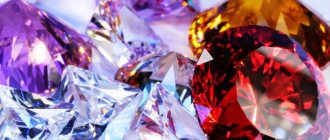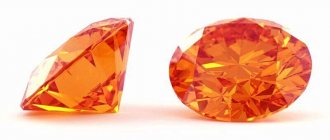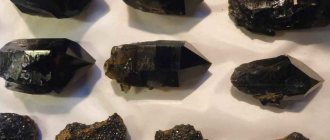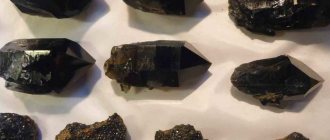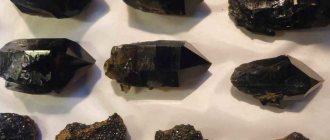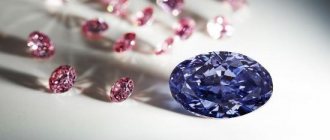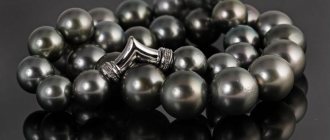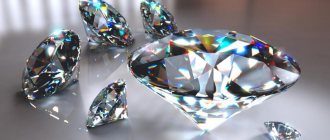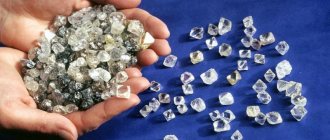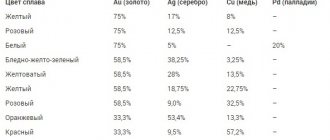Herbaceous gems have a long history. Man isolated them from a number of other minerals, associating green stone with life, safety and tranquility. Today, such minerals are actively used in the jewelry industry and in the production of decorative goods. And the variety of shades allows you to combine them with any materials.
Green Gems
TYPES AND FEATURES OF GREEN STONES
Before the advent of chemistry and physics, stones were divided only by appearance and hardness. Therefore, different but outwardly similar minerals were often given the same names. Today, green minerals have been studied in detail; each has a description and its own name.
At the moment, there is no generally accepted classification that would clearly separate precious and semi-precious green stones. However, in the post-Soviet space there are three main groups:
- jewelry (precious);
- ornamental, intended for the production of stone-cutting products (boxes, vases, panels, etc.);
- intermediate group of jewelry and ornamental minerals (semi-precious).
Precious
Gemstones are characterized by rarity, unique pure colors and optical effects, as well as high parameters:
- transparency;
- hardness;
- shine.
Emerald
Emeralds are the most famous green gemstones. The mineral is a variety of beryl colored with a characteristic grass-green color by oxides of chromium or vanadium.
Emerald
Characteristics:
| Hardness | 7,5–8 |
| Shine | glass |
| Refractive index | 1.56–1,60 |
| Transparency | transparent, translucent |
Peculiarities:
- Unlike most precious stones, the main criterion for the value of an emerald is its uniform shade, and only then its transparency is assessed.
- Evenly colored, transparent gems of rich color and weighing more than 5 carats are valued more than diamonds.
- Flawless emeralds are rare. The stone is characterized by numerous internal cracks and cavities, which make it brittle, despite its high hardness.
- Artificial emeralds are free from defects, but have bluish tints and a weaker shine.
- Some laboratories manage to create stones that are indistinguishable from natural ones in color and shine. But such technologies are kept secret.
Alexandrite
Alexandrite is a light green stone, a type of chrysoberyl, colored with chromium impurities. The gem is characterized by bluish, olive or grassy green shades.
Alexandrite
Characteristics:
| Hardness | 8,5 |
| Shine | glass |
| Refractive index | 1,74–1,75 |
| Transparency | transparent |
Peculiarities:
- A distinctive feature of alexandrite is the color change (pleochroism) from green to crimson or purple under artificial light.
- Some crystals have a cat's eye effect.
- In daylight and without specialized tests, alexandrite can easily be confused with some varieties of emerald.
- Stones with the trade name "artificial alexandrite" are actually synthetic corundum or synthetic spinel
- Alexandrite was found in Russia in 1842 and was long the stone of the Russian imperial family. Now it is mined in Brazil, South Africa, Madagascar, Sri Lanka and the Urals.
Sapphire
A derivative of corundum, sapphire is found in all colors. However, green stones (other names are chlorosapphire or oriental emerald) make up only 5% of the total volume of sapphires mined. The range of colors is wide: from light yellow-green to olive, blue-green and sea green.
Sapphire
Characteristics:
| Hardness | 9 |
| Shine | glass |
| Refractive index | 1,76–1,77 |
| Transparency | transparent |
Peculiarities:
- Richly colored cut green sapphires are rarely larger than 3 carats.
- Light green sapphires, like any sapphires except blue ones, are called fancy.
- In many sapphires, the green color is dim, with blue tints, as it is obtained through a combination of blue and yellow colors. An exception are crystals from Sri Lanka - thanks to chlorine impurities, they receive a rich emerald hue.
- Stones are characterized by the effects of adularization (shimmering of the surface) and iridescence (the appearance of a multi-rayed star on the surface). Such optical effects significantly increase the cost of sapphire.
- Green sapphires are mined in Sri Lanka, Australia, Russia and Thailand.
We recommend: Such a different mineral CORUND
Diamond
Diamond is the most durable of minerals and can last indefinitely. The stone is rare in green color and its color is due to:
- nitrogen impurities - translucent minerals are often formed;
- irradiation with uranium or thorium during the formation of a crystal - the saturation and depth of penetration of the tone depends on the strength and duration of irradiation. If the irradiation was weak or short-lived, only the upper layers of the stone are painted, which are crushed during grinding.
Diamond
Characteristics:
| Hardness | 10 |
| Shine | diamond |
| Refractive index | 1,69–1,70 |
| Transparency | transparent |
Peculiarities:
- The largest and most famous diamond of this color is the Dresden Green Diamond. Its weight is 41 carats. The stone received its apple-green color due to natural radioactive radiation.
- In nature, green diamonds are usually found in light colors with yellow tints. Before sale, the color of such samples can be artificially enhanced by irradiation. Since the process is identical to natural ones, it is extremely difficult to distinguish such a diamond from a natural one. But the price of “improved” stones will still be lower.
- Most green minerals were found in South Africa, Australia, Congo, Brazil, India and Siberia.
Semi-precious
Compared to precious stones, semi-precious stones have a lower hardness on the Mohs scale and often have a weaker luster. However, the clarity, rich colors and budget price make green crystal popular with buyers.
Chrysolite
Chrysolite (or peridot) is a representative of silicates and a type of olivine mineral. The stone is characterized by warm, golden-green shades ranging from pale to rich. The color is determined by impurities of nickel, iron and chromium.
Chrysolite
Characteristics:
| Hardness | 6,5–7 |
| Shine | diamond |
| Refractive index | 1,69–1,70 |
| Transparency | transparent |
Peculiarities:
- The second name of peridot - “evening emerald” - comes from the crystal’s ability to pleochroism. At dusk and in artificial light, the color of the stone can change from light green to cold green.
- Crystals with the “cat's eye” effect are considered the rarest and most valuable.
- Chrysolite is a common stone, so it is practically not counterfeited. However, it can be used to imitate a more valuable emerald.
- The most important deposits are located in Egypt, Pakistan, USA, Australia, Brazil, Sri Lanka, Afghanistan, Egypt, Tanzania and South Africa
Beryl
Often found in the bowels of the earth, beryl gets its green color from impurities of chromium, vanadium and iron. Usually the mineral forms opaque ornamental aggregates. Semi-precious crystals include rarer transparent crystals. Some varieties of beryl (for example, emerald) are distinguished into separate stones. Beryl proper (“noble beryl”) is an apple-green mineral of low purity.
Beryl
Characteristics:
| Hardness | 7,5–8 |
| Shine | glass |
| Refractive index | 1,56–1,60 |
| Transparency | transparent cloudy, translucent |
Peculiarities:
- Actually, beryl differs from emerald in lower purity.
- The stone is characterized by shades of yellow.
- Based on color saturation, “noble ordinary beryl” is also distinguished - relatively transparent, but with a pale color.
- Noble beryl is mined mainly in the East Indies, Brazil and Colombia. Noble ordinary - in Bavaria, France, England and Russia.
Chrysoberyl
Chrysoberyl is a rare beryllium mineral. Green crystals of chrysoberyl are obtained due to impurities of iron and chromium. The stones have a yellowish tint, but there are also specimens with blue, yellow, gray or brown tints.
Chrysoberyl
Characteristics:
| Hardness | 8,5 |
| Shine | glass |
| Refractive index | 1,74–1,75 |
| Transparency | transparent, translucent |
Peculiarities:
- The name “Chrysoberyl” was known back in antiquity: Pliny the Elder and his contemporaries called golden beryl that way. Today, chrysoberyls are classified as a separate group of minerals, a variety of which is the precious alexandrite.
- Translucent crystals have a “cat’s eye” effect. Such stones are cut into cabochons.
- Deposits are common. The largest of them are located in Ceylon, Madagascar, Brazil, Russia, Sweden and the USA.
We recommend: TOP 5 widow's stones
Zoisite
Zoisite (zahualpite) is a silicate with iron impurities; it is a pistachio-green stone with pink inclusions.
Zoisite
Characteristics:
| Hardness | 6–6,5 |
| Shine | glass |
| Refractive index | 1,69–1,70 |
| Transparency | transparent, translucent |
Peculiarities:
- The pink inclusions in the crystals are another type of zoisite - thulite.
- Valued for its spectacular contrasting color transitions.
- It is mined in Tanzania, Kenya, Zambia, Russia, USA, Mexico, Austria, Norway, Switzerland.
Pomegranate
Garnets are a large group of silicates that form crystals of any color except blue. Garnets in shades of green include grossular, uvarovite and demantoid.
Grossular
It is a green stone with a brown or yellow tint, colored with impurities of iron and chromium.
Grossular
Characteristics:
| Hardness | 6,5–7,5 |
| Shine | glass, wax |
| Refractive index | 1,73–1,78 |
| Transparency | transparent, translucent |
Peculiarities:
- The mineral received its name from the Latin “grossularia” - gooseberry due to its similarity with its fruits.
- Even processed crystals are characterized by dullness, fibrousness, cracks and cavities, and black spots.
- The mineral is mined mainly in Russia and the USA, and to a lesser extent in Brazil, Ukraine, and Madagascar.
Uvarovite
Uvarovite forms transparent green stones, the shades of which depend on the impurities:
- iron - juicy emerald;
- titanium - rusty green.
Uvarovite
Characteristics:
| Hardness | 6,5–8 |
| Shine | glass |
| Refractive index | 1,80–1,84 |
| Transparency | transparent, translucent |
Peculiarities:
- Uvarovite brushes and druses are highly valued as collection material. Crystals larger than 3 centimeters in height are considered unique, since usually the size of a uvarovite crystal does not exceed 1 cm.
- There are known deposits in the Urals, Canada, Finland, and North America.
Demantoid
Dark green demantoid stones are the most valuable type of garnet, colored with iron and chromium.
Demantoid
Characteristics:
| Hardness | 6,5–8 |
| Shine | diamond |
| Refractive index | 1,83–1,90 |
| Transparency | transparent, translucent |
Peculiarities:
- The brilliance of demantoid, especially in artificial light, significantly exceeds the brilliance of other garnets and is similar to the sparkle of a diamond.
- Demantoids are characterized by parallel golden filaments of bisolite or hollow tubules (“pony tail”). Such inclusions increase the price of the stone.
- There are crystals with a “cat’s eye” effect.
- It is mined in Tanzania, Kenya, Namibia, Karelia, Chukotka and Madagascar.
Moldavite
“Bottle stone” moldavite (or vltavin) is one of the types of natural glass. The crystals are bottle green in color, sometimes with a strong brown tint.
Moldavite
Characteristics:
| Hardness | 5–6 |
| Shine | glass |
| Refractive index | 1,49 |
| Transparency | transparent, cloudy |
Peculiarities:
- Crystals are characterized by the presence of gas bubbles inside.
- The nature of the appearance of moldavite is unknown. The main theory is that the mineral is formed due to the fall of large cosmic bodies to the earth.
- The size of moldavite pieces rarely exceeds 3 cm.
- Has no deposits. It is found locally throughout the planet.
Ornamental
A green mineral that does not have sufficient properties of transparency, brilliance or strength is classified as an ornamental mineral. Their value is inferior to precious and semi-precious ones, but the variety of textures opens up great opportunities for artisans.
Chrysoprase
Chrysoprase is a valuable mineral from the chalcedony family. Nickel impurities give it a unique mint green color.
Chrysoprase
Characteristics:
| Hardness | 6,5–7 |
| Shine | glass or wax |
| Refractive index | 1,53 |
| Transparency | translucent, opaque |
Depending on color and uniformity, it belongs to different classes:
- spotted, pale-colored - ornamental stone.
- homogeneous emerald - the highest grade, semi-precious, used in jewelry along with precious pieces;
- uniform apple green - first grade, semi-precious stone of the lower order;
Peculiarities:
- The mineral mainly forms aggregates of the ornamental series. Jewelry crystals are found rarely and in small volumes.
- Chrysoprase lends itself well to polishing, but achieving a mirror shine is extremely difficult.
- It is mined in Fazylbek, Queensland, Australia, Germany, Poland, Kazakhstan, Arizona, California and Brazil.
Nephritis
An opaque pale green stone, jade is a valuable ornamental mineral used by humans since Neolithic times.
Nephritis
Characteristics:
| Hardness | 6–6,5 |
| Shine | fatty |
| Refractive index | 1,62 |
| Transparency | opaque, translucent |
Peculiarities:
- Due to its high “viscosity”, the mineral is easy to process, but difficult to break or split.
- Samples with a uniform color are the most expensive.
- The cat's eye variety of jade is rare and prized by jewelers.
- Jade is the national stone of China and has long been valued there along with precious metals and gems.
- The main deposits are located in China, Russia, Canada, USA, Australia, and New Zealand.
We recommend: RARE STONES - lucky to see them, lucky to have them
Jade
A silicate mineral similar in appearance to jade. Often in trade registers these stones are referred to under the general name “jad”.
Jade
Characteristics:
| Hardness | 6,5–7 |
| Shine | bold, sometimes with a pearlescent tint |
| Refractive index | 1,65–1,66 |
| Transparency | opaque, translucent |
Peculiarities:
- Jadeite is characterized by a fine-grained structure, visible to the naked eye.
- Imperial is the most valuable variety of jadeite, which is a homogeneous emerald translucent or transparent crystal.
- Chloromelanite is a dark green jadeite with black spots.
- Jade-albite is an aggregate of albite and jadeite, saturated green with dark spots. It is mined only in Myanmar.
- Large deposits have been discovered in Myanmar, China, Japan, Guatemala, Mexico, USA, Kazakhstan, and Russia.
Malachite
Malachite is a copper carbonate with iron impurities, forming fused round aggregates (spherulites) of a rich green color in cold tones.
Malachite
Characteristics:
| Hardness | 3,5–4 |
| Shine | silky matte or glass |
| Refractive index | 1,65–1,90 |
| Transparency | opaque |
Peculiarities:
- The stone is characterized by concentric patterns of alternating dark and light layers.
- For the manufacture of jewelry, interior items and decor, only durable malachite of the highest grade is used. The velvet (fleece) variety has a grainy texture and is difficult to process.
- Stalactite-like malachite aggregates of unusual shapes are collector's items.
- They are mined in places with copper deposits, including the Urals, the USA, China, Australia and Africa.
Coil
Serpentine or serpentinite is a representative of metamorphic rocks and consists of serpentine group minerals processed by nature with admixtures of carbonates, garnet, olivine, pyroxene, amphiboles, talc, ore minerals magnetite, chromite, etc.
It is characterized by a green color with multi-colored spots.
Coil
Characteristics:
| Hardness | 2,5–4 |
| Shine | glassy, waxy or greasy |
| Refractive index | 1,55–1,80 |
| Transparency | opaque |
Peculiarities:
- Depending on the inclusions, antigorite, chrysolite, bronzite, garnet and other serpentinites are distinguished.
- The most valuable variety is ophite (noble serpentine), a durable, translucent yellow-green serpentine with a waxy sheen at the edges.
- Mined in the USA, Great Britain, Germany, Austria, Switzerland, Poland, Russia
Amazonite
Amazonite is a relatively rare turquoise silicate with white and grayish veins.
Amazonite
Characteristics:
| Hardness | 6–6,5 |
| Shine | glass |
| Refractive index | 1,55–1,80 |
| Transparency | opaque, translucent around the edges |
Peculiarities:
- The mineral attracts attention with regular patterns of albite, similar to writing.
- It was named after the Amazon River, where it was allegedly first found. In fact, the mineral in the Amazonian deposits turned out to be jade, which was established later. However, the name was left behind the stone.
- Due to its rarity and spectacular color, it often finds its way into collections.
- It is mined in Russia, Kazakhstan, Ukraine. The best samples come from the USA.
White opal
Pictured: white opal from Australia, 20.82 carats
Opal is a precious stone that combines a number of varieties. The name “opal” is translated as “enchanting sight” (from the Latin “opalus”), and in Sanskrit “fell” means a noble stone. Among its types are the so-called “white opals” with a light base tone. At the same time, opalescence can be observed in them in the form of bright iridescent colored spots. The most transparent white opals are mined in Ethiopia, the color of which ranges from light yellowish to bluish tones. The most expensive opals of this variety are found in Australia. They are also found in Brazil.
VIEW ALL OPALS
JEWELRY WITH GREEN STONES
Using light green stones in jewelry, craftsmen select a frame that matches the tone of the mineral. For warm green shades, gold, copper, and brass are usually used. For greenish minerals of cool tones - silver and other white metals.
Nature gives green gems a variety of textures and shades. That's why they attract so much attention. Emerald-colored minerals are special and do not suit every outfit. But their diversity allows you to choose the right stone to suit your taste.
Related publications
- Review of BLACK STONES
- TOP 5 widow's stones
- Review of 13 PINK GEMS
- MINERALS IN THE COLOR OF THE SKY
Colorless sapphire
In the photo: near colorless sapphire, 5.40 carats, Sri Lanka
Colorless sapphire is a transparent gemstone, a type of corundum. The second name for colorless sapphire is leucosapphire. If transparency is poor, it may appear white due to a large number of tiny whitish inclusions of rutile. In large, almost colorless sapphires, you can sometimes notice a slight tint, for example, blue, purple or yellow. Colorless sapphires have high hardness and excellent shine. In jewelry they can also be an alternative to more expensive diamonds. Mining of such sapphires is mainly carried out in Sri Lanka.
VIEW SAPPHIRE
Who needs a gray talisman?
Gray stones are energetically in tune with water. People whose lives are connected with this element are recommended to wear such jewelry constantly. Minerals have a positive effect on all zodiac signs except Pisces. Stones aggravate their passivity and cause increased sensitivity to stress.
Amulets protect against negative magical effects caused by other stones or people. They minimize the manifestation of negative character traits only with constant, long-term wearing of the amulet. Esotericists believe that gray minerals and rocks calm evil spirits, helping them find peace.
Although gray does not attract attention, it has strong magical and healing effects, and also goes well with any part of its owner's wardrobe. Among rocks, this color is considered common, but for precious stones it is extremely rare. Gray minerals stand out for their simple beauty and also promote confidence and self-esteem.
